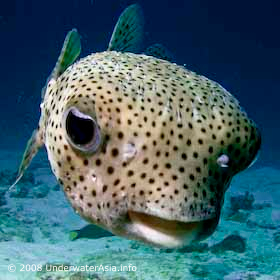It began as a normal day at Walmart with my two daughters. We wandered around the clothes section, they begged for just one more Littlest Pet Shop, and we tried all the free samples we could find. Then one of the girls suggested, “Let’s get a fish.” It happened to be one of the fish-free cycles in our home, so when my daughter suggested it, the other one jumped aboard.
 We took a stroll past the fish tanks and when I saw the tiny puffer fish, I was hooked. They are so cool: cute and harmless until threatened. Then, poof, with one gulp of water they double in size and become covered with death-threatening spikes.
We took a stroll past the fish tanks and when I saw the tiny puffer fish, I was hooked. They are so cool: cute and harmless until threatened. Then, poof, with one gulp of water they double in size and become covered with death-threatening spikes.
“That’s the one I want,” six-year-old Julia said pointing at the cutest ball of porcupine potential in the tank.
Her older sister, MaryLynn, decided that she liked the colorful neon tetras.
Both great choices, but we only had one tank. I stopped a worker as he hurried past to ask about putting the two fish in the same tank.
“Oh, they should be fine,” he said. “The puffer fish are really slow and the tetras are quick. I’m sure they’ll stay away from the puffer.”
That sounded reasonable to me. “Ok,” I answered in a fit of motherly generosity. “Let’s get one puffer fish and four little tetras.”
Julia reached for the bag and the two girls chattered and giggled all the way up to the register while they began picking out names. By the time we took our place in line the puffer fish was dubbed Simba and the tetras were getting names like Sunshine and Sky.
Suddenly, MaryLynn squealed, “Mom, he’s eating them, Mom!”
I grabbed the bag and peered in to see a half a fish floating in the bag and Simba trying to take a chunk out of another tetra. MaryLynn burst into tears and began mourning her poor little Sunshine. “He was so cute. He didn’t deserve it.”
In the meantime, I was trying to keep the puffer from consuming another pet. I used the tool I had on hand, my credit card. I began poking through the bag at Simba. “Stop it,” I command the fish, as if he might suddenly hear and obey me.
By this time, Julia started crying too. Her adorable pincushion had turned into a mass murderer right before her eyes. She sobbed, “I didn’t know he would eat them, I didn’t know.”
Comments of the shoppers behind us began to filter through the scene that was my family.
“What’s going on up there?”
“Great, two crying children, glad I went shopping today.”
And the most helpful was, “Don’t you know that puffers are aggressive? They’ll eat anything they can catch.”
No, obviously I didn’t know this. You think I planned the fish massacre?
I finally realized that the credit card poking wasn’t working when I witnessed Simba chomp another fish in two. This brought another round of shrieks from both children. They buried their blotched faces in my stomach, and I held the bag up high as if I could keep the carnage from them. But I finally hit upon a plan that brought the slaughter to an end. I used the credit card to push into the bag and form two separate pools, keeping the puffer and what was left of the tetras apart.
Finally, it was my turn at the register.
 I smiled sweetly, handed the bag of half-eaten tetras and one well-fed puffer to the cashier and said, “You might want to tell the man back by the fish that puffers DO NOT do well with other fish.” I took each of my traumatized girls in hand and walked out leaving the cart of groceries sitting in line and the confused cashier clutching the miniature crime scene.
I smiled sweetly, handed the bag of half-eaten tetras and one well-fed puffer to the cashier and said, “You might want to tell the man back by the fish that puffers DO NOT do well with other fish.” I took each of my traumatized girls in hand and walked out leaving the cart of groceries sitting in line and the confused cashier clutching the miniature crime scene.